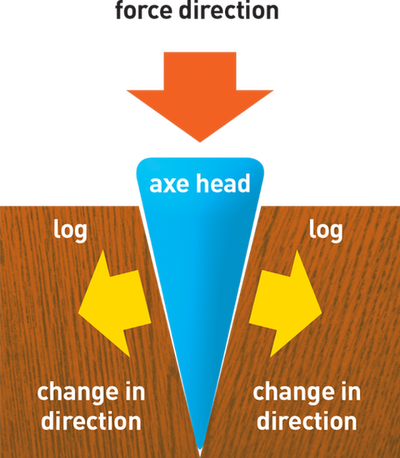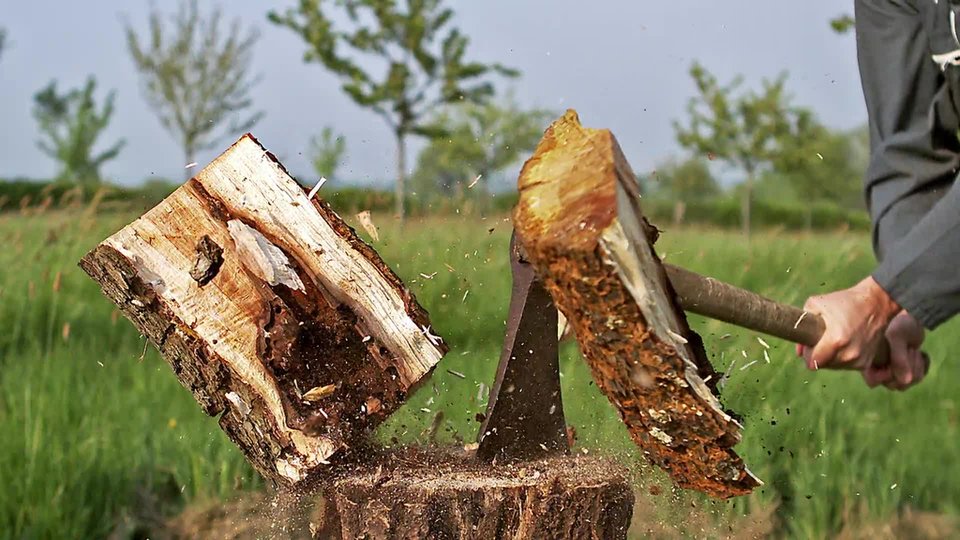Problem
You arecampingwithyourfamilyandyourbestfriend.Afteradayoffuninthesun,youlookforwardtoanightnexttoabright,blazingcampfire.Especiallybecauseit’syourturntohelpstart it!
Youandyourfriendgathersomelogsandcrisscrosstheminasmallpile.Youraunttriestolightoneofthelogswithamatch.Nothinghappens.Shesmiles.“Thelogsaretoobigtocatchonfirewithsuchalittle flame.”
“Weneedsmallerpieces,”yousay.Buthow?Thewoodistoohardtobreakapartwithyourhands.“Weneedsomesortoftool,”yourfriendsays.“Maybesomeoneinthecampgroundhasasaw.”Allthatbackandforthsawingcouldtakeawhile,youthink.Theremustbeabetter tool.
Solution
Thereis!Yourememberseeingasmallaxeinaboxofcampingequipment.It’stheperfecttoolforthe job!
Youbringittoyouraunt.Shestandsalogupandcarefullyswingstheaxesothatthebladestrikesthecutwoodontop.THWACK!Thelogsplitstoitshalfwaypoint.Anotherswing,and CRACK!It splitsin two.Afewmorewhacksreducethehalflogstopiecessmallenoughtostartthe fire.
Problem solved!
It'sSimple
Whatmakestheaxeagoodtooltosplitwood?It’ssimple!Theaxeheadisasimplemachine.Likeallmachines,simplemachineshelpusdojobs,usuallybymovingthingsfaster,farther,ormoreeasilythanwecanwithout them.
Youprobablydon’tthinkofanaxeheadwhenyouhearthewordmachine.Ablender,acar,orabulldozermightcometomind.Buttheseareallcomplexmachines.Theyhavelotsof parts.
Simplemachineshaveonlyafewparts.Infact,some aremadeofonlyonepart.Nearlyeverymachine,nomatterhowcomplex,containsoneormoresimple machines.
Simplemachinescanbecombinedinendlesswaystocompletetasks,frompullingaloadtoflyinginspace.Buteachhelpsusdoworkallonits own.

AWedgeGivesYouanEdge
Theaxeheadthatyouusedtosplitthewoodisasimplemachinecalledawedge.It’sshapedlikeatriangle.Atfirst,itmightlooklikeasquare.Butlookdownatthetopofit.Theheadstartsoutwideandthennarrowstoathinedge.Thethinnertheedge,thesharperthe wedge.
Howdoesitwork?Itstartswith effort fromyou.Ittakesefforttoswingtheaxe.Thiseffortprovidesthe force todrivetheaxeintothe wood.
Asyouswingtheaxe,theforcemovesdownward.Butastheaxepushesintothewood,thewedge shapedirectsthatforcesideways.Awedgeredirectsforce.Astheaxedrivesdeeper,thewoodmovesfartherandfartherapart,until,withonefinalCRACK, it splits.
WithapowerfulCHOP, thisaxesplitsthewoodin two.Theaxeheadisawedge.
It’sAllAboutTrade-offs
Now, supposeyouhadtwoaxestochoosefrom.Onehasaheadthatislongandnarrow.Theotherisshorterandwider.Whichwouldyou choose?
Remember,thethinnerthewedge,thesharpertheedge.So,thelong,narrowaxeheadwillbesharper.Choosingthisoneisano-brainer.Itwillbeeasiertodriveintothewoodwitheach swing.
Buthere’sthethingaboutasimplemachine:Therearealwaystrade-offs.Thelong,narrowaxeiseasiertopushintothewood,butithastogodeeperbeforeitsplitsthelog.Theshort,wideaxecouldsplitthewoodwithoutgoinginsodeep.Thismightmeanfewerswings,buteachswingwouldrequirealotmoreforce.Youtradedistanceforeffort.Notabad trade!
